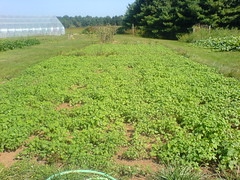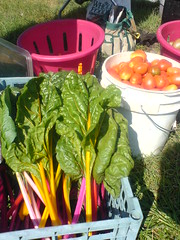Back to school, in the garden! Three weeks ago, we decided to sow a
cover crop of buckwheat in an area of the garden where we had grown potatoes. Cover crops can have several positive impacts on the organic garden system. First, cover crops add biomass and build organic matter in the soils, breaking up clay soils and making more nutrients available to crops that follow. Some cover crops, like legumes and clovers, fix nitrogen from the air into the soil, working cooperatively with soil bacteria to do so. Cover crops can outgrow and smoother weeds (especially buckwheat, which has to be the fasting growing non-weed we’ve ever seen!), and can also facilitate the disruption of pest and disease cycles in the garden. Cover crops tend to have a ‘mellowing’ effect on the soil, and also protect soil from erosion & the elements.
Point is, cover crops are cool. Problem is, many of us organic gardeners know that cover crops are a good thing, yet can never seem to get around to actually sowing them in our garden. The two main barriers to a lack of cover crops in the organic garden are space & seed. Unless you live in the outerburbs, many garden centers do not carry cover crop seed. And unless you have a large garden, it may seem like a waste of space to put a section of the garden in cover crop.
The key to using cover crops begins with having a stockpile of cover crop seed on hand. Most garden catalogues carry cover crop seed in small enough increments to use over the course of a couple years in the backyard. Four good cover crops to have in your closet are: buckwheat, oats, winter-rye, and white clover. If you have an area that is ‘spent’, like an early planting of squash, and are not about to do a second planting, just get out there and broadcast some of your cover crop seed. It’s fun, and makes you feel like a wise gardener. Buckwheat is a fast-growing summer cover crop, but does not do well in the cold. When the frost kills your tomatoes, you still might be able to sow a cold-hardy cover like winter-rye. Each cover crop has its purpose and place in the organic garden system.
Now that you have the seed, you might find yourself with a space problem, particularly in the urban garden. The space problem can be solved through the technique of undersowing, or getting cover crops started a few weeks before a particular vegetable crop is done, right underneath the vegetables, in the same bed. For instance, now’s a great time to ‘undersow’ your tomatoes with oats. The oats germinate, grow up a few inches, then the tomatoes die back, and the oats can carry on into the fall before eventually dying after several hard frosts. Eliot Coleman, the Maine organic farmer and author, writes extensively about undersowing cover crops in his book, The New Organic Grower.
Once you get started with cover crops, you won’t want to stop. Buckwheat is a great one to start with, and you can probably still sow it this week, giving you a few weeks of growth before the first killing frost…





